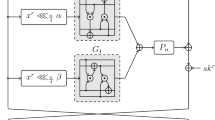Abstract
This work considers the problem of increasing the performance of the ciphers based on Data-Dependent (DD) operations (DDO) for VLSI implementations. New minimum size primitives are proposed to design DDOs. Using advanced DDOs instead of DD permutations (DDP) in the DDP-based iterative ciphers Cobra-H64 and Cobra-H128 the number of rounds has been significantly reduced yielding enhancement of the “performance per cost” value and retaining security at the level of indistinguishability from a random transformation. To obtain further enhancement of this parameter a new crypto-scheme based on the advanced DDOs is proposed. The FPGA implementation of the proposed crypto-scheme achieves higher throughput value and minimizes the allocated resources than the conventional designs. Design of the DDO boxes of different orders is considered and their ASIC implementation is estimated.
Similar content being viewed by others
References
A.A. Waksman, Permutation Network, Journal of the ACM 15 (1968) 159–163.
D.S. Parker, Notes on shuffle/exchange-type switching networks, IEEE Transactions on computers C-29(3) (1980) 213–222.
M. Portz, A generallized description of DES-based and Benes-based permutation generators, Springer-Verlag LNCS 718 (1992) 397–409.
M. Kwan, The design of the ICE encryption algorithm, Springer-Verlag LNCS 1267 (1997) 69–82.
B. Van Rompay, L.R. Knudsen, and V. Rijmen, Differential cryptanalysis of the ICE encryption algorithm, Springer-Verlag LNCS 1372 (1998) 270–283.
R.L. Rivest, The RC5 Encryption Algorithm, Springer-Verlag LNCS 1008 (1995) 86–96.
R.L. Rivest, M.J.B. Robshaw, R. Sidney, and Y.L. Yin, The RC6 Block Cipher, 1st Advanced Encryption Standard Candidate Conference Proceedings, Venture, California, Aug. 20–22, 1998.
J. Pieprzyk, Th. Hardjono, and J. Seberry, Fundumentals of Computer Security. Springer-verlag. Berlin (2003) 677.
C. Burwick, D. Coppersmith, E. D'Avingnon, R. Gennaro, Sh. Halevi, Ch. Jutla, Jr. S.M. Matyas, L. O'Connor, M. Peyravian, D. Safford, and N. Zunic, MARS—-a Candidate Cipher for AES, 1st Advanced Encryption Standard Candidate Conference Proceedings, Venture, California, Aug. 20–22, 1998.
A.A. Moldovyan and N.A. Moldovyan, A cipher based on data-dependent permutations, Journal of Cryptology 15 (2002) 61–72.
N.D. Goots, B.V. Izotov, A.A. Moldovyan, and A.N. Moldovyan, Fast Ciphers for Cheap Hardware: Differential Analysis of SPECTR-H64, Springer-Verlag LNCS 2776 (2003) 449–452.
N.A. Moldovyan, Fast DDP-Based Ciphers: Design and Differential Analysis of Cobra-H64, Computer Science Journal of Moldova 11(3) (2003) 292–315.
N. Sklavos, N.A. Moldovyan, O. Koufopavlou, High Speed Networking Security: Design and Implementation of Two New DDP-Based Ciphers, Mobile Networks and Applications 10 (2005) 237–249.
Z.J. Shi and R.B. Lee, Bit permutation Instructions for Fast Software Cryptography, Proceedings of the IEEEInternational Conference on Application-specific Systems, Architecture and processors, Boston, Massachusetts, USA, (July 10-12, 2000) pp. 138–148.
R.B. Lee, Z.J. Shi, and X. Yang, Efficient permutation instructions for Fast Software Cryptography, IEEE Micro 21(6) (2001) 56–69.
R.B. Lee, Z.J. Shi, R.L. Rivest, and M.J.B. Robshaw, On permutation operations in Cipher Design, Proceedings of the International Conference on Information Technology: Coding and Computing (ITCC'04), Las Vegas, Nevada April 5–7 (2004) vol. 2 pp. 569–579.
N.A. Moldovyan, N.D. Goots, P.A. Moldovyanu, and D.H. Summerville, Fast DDP-Based Ciphers: from Hardware to Software, Proceedings of the 46th IEEE symposium “Midwest 2003”, Egypt, Cairo (December 26–29, 2003).
B. Preneel et al., Comments by the NESSIE project on the AES finalists. May 24, 2000 http://www.nist.gav/aes
Changhoon Lee, Deukjo Hong, Sungjae Lee, Sangjin Lee, Hyungjin Yang, and Jongin Lim, A chosen plaintext linear attack on block cipher CIKS-1, Springer-Verlag LNCS 2513 (2003) 456–468.
N.A. Moldovyan, A.A. Moldovyan, and N.D. Goots, Variable Bit Permutations: Linear Characteristics and Pure VBP-Based Cipher, Computer Science Journal of Moldova 13 (2005) 84–109.
Youngdai Ko, Deukjo Hong, Seokhie Hong, Sangjin Lee, and Jongin Lim, Linear Cryptanalysis on SPECTR-H64 with Higher Order Differential Property, Springer Verlag LNCS 2776 (2003) 298–307.
N.A. Moldovyan, On Cipher Design Based on Switchable Controlled Operations, Springer-Verlag LNCS 2776 (2003) 316–327.
N. Sklavos, A.A. Moldovyan, and O. Koufopavlou, Encryption and Data Dependent Permutations: Implementation Cost and Performance Evaluation, Springer-Verlag LNCS 2776 (2003) 337–348.
A. J. Elbirt, W. Yip, B. Ghetwynd, and C. Paar, An FPGA Implementation and Performance Evaluation of the AES Block Cipher Candidate Algorithm Finalists, 3rd Advanced Encryption Standard Conference Proceedings, New York, NY, USA http://www.nist.gov/aes(April 13-14, 2000).
Author information
Authors and Affiliations
Corresponding author
Rights and permissions
About this article
Cite this article
Moldovyan, A.A., Moldovyan, N.A. & Sklavos, N. Controlled elements for designing ciphers suitable to efficient VLSI implementation. Telecommun Syst 32, 149–163 (2006). https://doi.org/10.1007/s11235-006-9135-5
Issue Date:
DOI: https://doi.org/10.1007/s11235-006-9135-5




